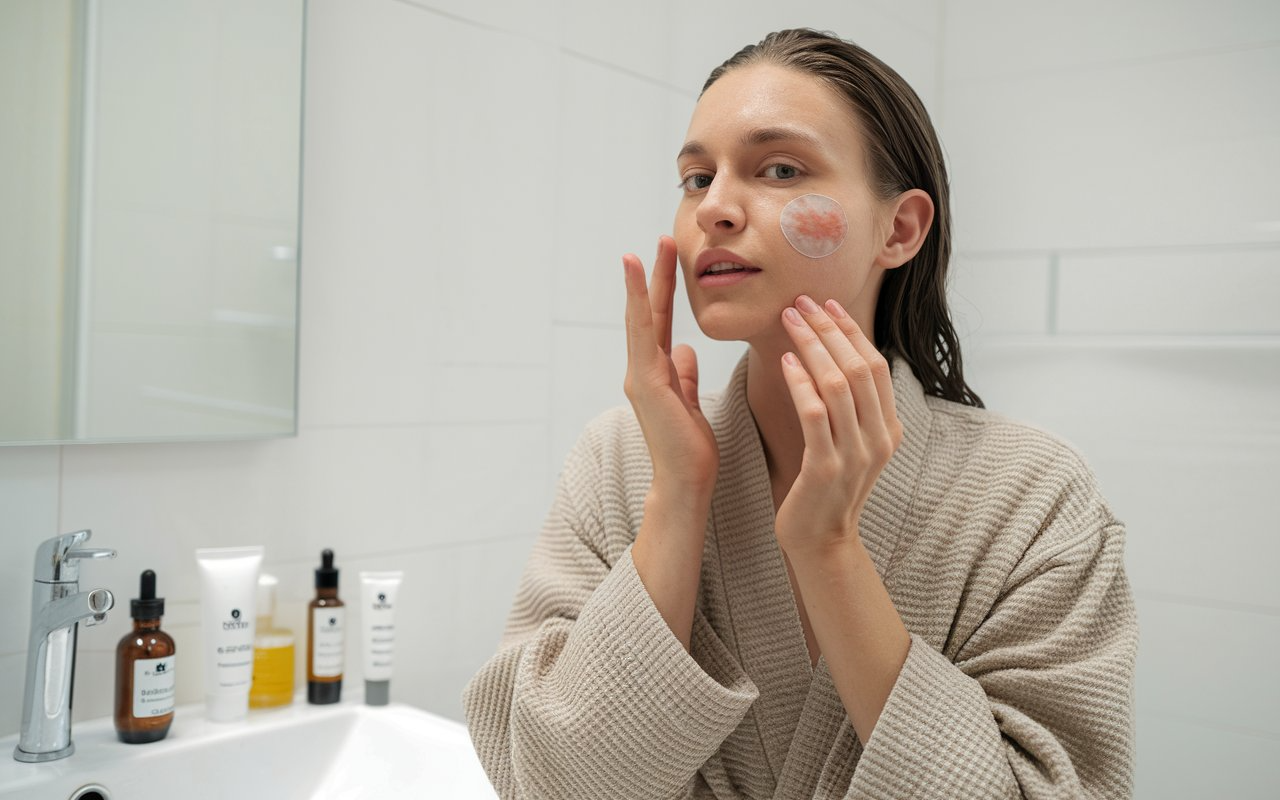Dealing with breakouts can be really frustrating for anyone. That’s why pimple patches are a game-changer. These small stickers target and treat active acne with great precision. But one question always seems to come up in my mind:
“Do you put pimple patches on before or after skincare?”
If you’ve ever been stuck staring at your skincare products and the tiny miracle sticker, unsure of what goes first, you’re not alone. As someone who’s battled acne and experimented with countless products, let me walk you through the answer—and a lot more.
What Are Pimple Patches?
Pimple patches are tiny adhesive stickers designed to treat acne. They work by absorbing pus, reducing redness, and protecting blemishes from dirt or picking (we’ve all done it, admit it!).
Types of Pimple Patches
There are two major types of pimple patches:
Hydrocolloid Patches
These are non-medicated and focus on sucking out gunk from your pimples while keeping the area moist for better healing.
Medicated Patches
These contain active ingredients like salicylic acid or tea tree oil to fight bacteria and reduce inflammation.
No matter which type you choose, they’re both great tools to have in your acne-fighting arsenal.
How Do Pimple Patches Work?
The magic lies in their ability to create an occlusive environment. Hydrocolloid patches draw out fluids, while medicated ones deliver acne-fighting ingredients directly to the spot.
Active Ingredients in Pimple Patches
Salicylic Acid: Unclogs pores and reduces redness.
Niacinamide: Helps calm inflammation and brighten the skin.
Tea Tree Oil: A natural antiseptic to kill acne-causing bacteria.
The effectiveness depends on the type of acne you’re dealing with. They work best for surface-level pimples, not cystic acne buried deep under the skin.
So, Do You Put Pimple Patches on Before or After Skincare?
You should apply pimple patches on clean, dry skin, before the rest of your skincare routine.
Why? If you place them after applying products like moisturizer or serum, the patch might not adhere well and won’t work as effectively. Think of the patch as your first line of defense—it needs direct contact with your skin to do its job.
Applying Pimple Patches Before Skincare
Step-by-Step Guide
- Cleanse your face thoroughly.
- Pat your skin completely dry.
- Stick the patch directly on the pimple.
- Continue with your usual routine around the patch.
Pros
- Maximum adhesion for the patch.
- Direct contact allows it to absorb impurities better.
Cons
- Limits where you can apply your skincare products.
Applying Pimple Patches After Skincare
Step-by-Step Guide
- Apply your skincare routine as usual.
- Wait until products are fully absorbed (about 10-15 minutes).
- Place the patch on the pimple.
Pros
- It allows you to complete your full routine without interference.
Cons
- The patch may not stick as well, especially on oily skin.
Special Considerations for Different Products
When using pimple patches with other acne treatments, watch out for active ingredients. Don’t put the patch over products with lots of salicylic acid or benzoyl peroxide. This could irritate your skin. Instead, use the patch as a spot treatment with your other treatments.
The right order for applying pimple patches in your skincare order and layering skincare routine depends on your skin and products. Try different ways to find what works best for you and your pimple patch application.
The Perfect Time to Apply Acne Patches for Maximum Effectiveness
Timing is everything when using acne patches. Whether for overnight or daytime use, knowing when to apply them is crucial. It can greatly impact your skin’s journey to health and clarity.
For overnight use, apply patches before bed. This lets the ingredients work all night. They draw out impurities and help your skin heal faster. Daytime patches, on the other hand, are great for covering up blemishes while you’re out.
It’s important to match patch use with acne stages. Use overnight patches at the first sign of a breakout. For more developed pimples, daytime patches are better. Understanding your skin’s needs and timing your application is key to their effectiveness.
How Long Should You Keep a Patch On?
The time you wear a pimple patch is key to getting good results. The right time depends on the acne type and the patch’s features. Here’s what you need to know about wearing time for pimple patches.
Most pimple patches should be worn for 6 to 12 hours. This lets the patch draw out dirt, reduce swelling, and help your skin heal. Pimple patch wear time is important to avoid skin irritation.
For tough pimples, you might need to wear the acne sticker duration for up to 24 hours. This longer time helps the patch reach deeper into the pimple. Just watch your skin and change the patch if it gets wet or starts to fall off.
When it’s time for a patch replacement, look for signs the patch has done its job. If it turns cloudy or opaque, it’s absorbed enough fluid and bacteria. Then, it’s time to take off the old patch and put on a new one.
Standard Pimple – 6-12 hours
Stubborn/Deep Pimple – Up to 24 hours
Factors That Influence Pimple Patch Placement
Your skin type, the type of acne you’re treating, and even your daily activities can affect how and when you use pimple patches.
Skin Type Considerations
Oily Skin: Clean the area thoroughly to ensure the patch adheres well.
Dry Skin: Be cautious not to over-strip your skin during cleansing.
Sensitive Skin: Opt for patches without harsh ingredients.
Expert Opinions on Pimple Patch Application
Dermatologists Recommend…
- Applying pimple patches on clean, dry skin for optimal results.
- Using patches overnight when your skin isn’t exposed to makeup or external irritants.
Common Mistakes to Avoid
- Reusing pimple patches.
- Leaving a patch on for too long (most work best when replaced every 6-8 hours).
- Applying them over makeup—this reduces their effectiveness.
How to Remove Them Properly
Peel gently from the edges to avoid skin irritation. If it’s stuck, dampen the area slightly to loosen the adhesive.
Top Suggestions for Pimple Patch
Hydrocolloid patches
Hydrocolloid patches are small adhesive stickers that help treat pimples by absorbing fluids and protecting the area from bacteria. Here are three popular hydrocolloid patch products:
Hero Cosmetics Mighty Patch

These patches are known for their ability to absorb pimple fluids and reduce inflammation. They are discreet and suitable for various skin types.
Skin Type
Oily, Combination, Sensitive, Dry, Normal
GET IT HERE ➡️ AMAZON
COSRX Acne Pimple Master Patch

These patches come in different sizes to fit various pimple sizes. They help reduce redness and protect the pimple from external factors.
Skin Type
Oily, Combination, Sensitive, Dry, Normal
GET IT HERE ➡️ AMAZON
Starface Hydro-Stars

These fun, star-shaped patches are designed to absorb fluids and protect pimples. They are popular for their playful design and effectiveness.
Skin Type
Oily, Combination, Sensitive, Dry, Normal
GET IT HERE ➡️ AMAZON
Peace Out Skincare Acne Dots

These hydrocolloid patches are infused with ingredients like salicylic acid to help treat acne while absorbing excess oils and fluids.
Skin Type
Oily, Combination, Sensitive, Dry, Normal
GET IT HERE ➡️ AMAZON
Medicated Patches
Medicated patches are adhesive products that deliver medication through the skin to treat various conditions. Here are four popular medicated patch products:
Salonpas Pain Relieving Patch

These patches contain menthol and methyl salicylate to relieve minor aches and pains associated with arthritis, backache, and muscle strains.
Skin Type
Oily, Combination, Sensitive, Dry, Normal
GET IT HERE ➡️ AMAZON
Icy Hot Medicated Patch

These patches provide temporary relief from minor muscle and joint pain by delivering a combination of menthol and methyl salicylate.
Skin Type
Oily, Combination, Sensitive, Dry, Normal
GET IT HERE ➡️ AMAZON
Flector Patch

This prescription patch contains diclofenac epolamine, a nonsteroidal anti-inflammatory drug (NSAID) used to treat acute pain due to minor strains, sprains, and contusions.
Skin Type
Oily, Combination, Sensitive, Dry, Normal
Butrans Patch

This prescription patch contains buprenorphine, an opioid used to manage chronic pain in patients requiring continuous, long-term opioid treatment.
Skin Type
Oily, Combination, Sensitive, Dry, Normal
Summary
The secret to success is to make your skincare routine better and choose the right treatments for acne. Knowing how pimple patches work and what’s in them helps you fight stubborn blemishes. So, use pimple patches wisely and let them be a key part of your fight against acne.
Everyone’s skin is unique, and you may need to experiment to find what fits best for you. Whether it’s before or after skincare, the ultimate goal is to feel confident and take care of your skin in a way that works for you.
Frequently Asked Questions
Q: Can You Wear Pimple Patches Under Makeup?
A: Yes, but make sure to use thin patches designed for daytime use. They’re great for reducing redness and creating a smoother base.
Q: How Long Should You Leave a Pimple Patch On?
A: 6-12 hours or until the patch turns white, indicating it has absorbed impurities.
Q: Are Pimple Patches Safe for Sensitive Skin?
A: Absolutely, as long as you choose patches without harsh active ingredients.
Q: How Do You Know if a Pimple Patch Is Working?
A: If it turns white after use, that’s a good sign it’s absorbed fluids.
Q: Can You Reuse a Pimple Patch?
A: No, reusing patches is unhygienic and reduces their effectiveness.

